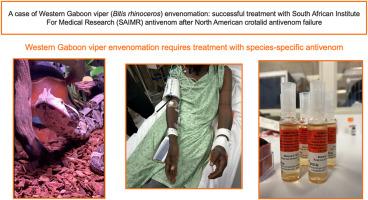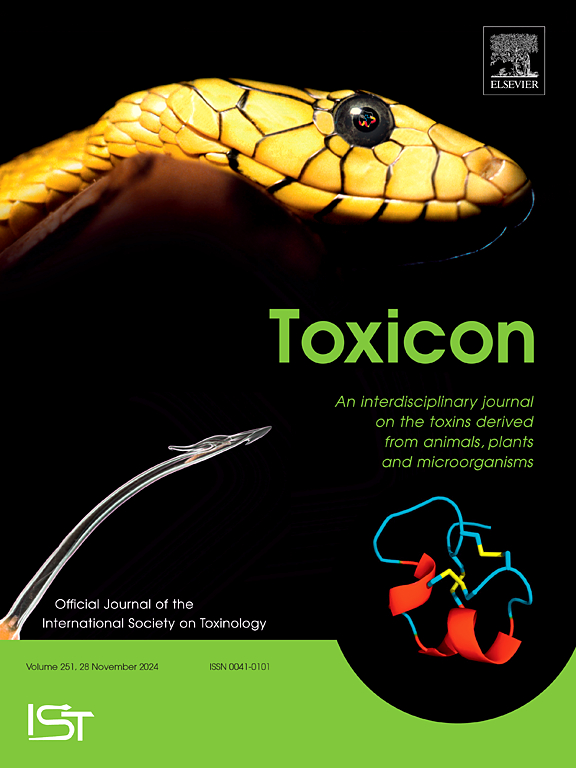A case of Western Gaboon viper (Bitis rhinoceros) envenomation: Successful treatment with South African Institute for Medical Research (SAIMR) antivenom after North American crotalid antivenom failure
IF 2.4
4区 医学
Q2 PHARMACOLOGY & PHARMACY
引用次数: 0
Abstract
We report a case of Western Gaboon viper (Bitis rhinoceros) envenomation in which the patient's symptoms progressed despite treatment with North American crotalid antivenom but improved after receiving South African Institute for Medical Research (SAIMR) polyvalent antivenom.
A 59-year-old man was hospitalized after reportedly being bitten by a Gaboon viper (Bitis gabonica). On arrival, he had normal vital signs, two puncture wounds on his left hand, and edema distal to the wrist. The hospital contacted the local poison center who conveyed that crotalid antivenom would be ineffective and recommended transfer to a snakebite center for species-appropriate antivenom. However, this recommendation was disregarded. Initial laboratory tests 2 hours after envenomation revealed a platelet count of 77 x 109/L; other parameters were normal. He received six vials of crotalid antivenom (CroFab®) followed by three maintenance doses (total 12 vials). The next morning, swelling had progressed proximal to the elbow and platelets decreased to 37 x 109/L. He was subsequently transferred and received SAIMR polyvalent antivenom. Six hours later, his platelets were 130 x 109/L. The next morning, his swelling had significantly improved. He was discharged the following day. After discharge, it was discovered that the snake was a Bitis rhinoceros.
Bitis gabonica and Bitis rhinoceros are popular captive snakes in the United States. Bitis rhinoceros was formerly a sub-species of B. gabonica, and they are often referred to interchangeably. Their venoms cause tissue edema, coagulopathy, and in severe cases, hemorrhage, dysrhythmias, and death. Antivenom is not widely available in the United States often necessitating patient transfer or antivenom delivery. This case addresses the question of whether crotalid antivenom, which is ubiquitous in the United States, can treat B. gabonica and B. rhinoceros envenomations and highlights the need for consultation with a poison center to facilitate administration of species-appropriate antivenom.

一例西部加蓬蝰蛇(Bitis rhinoceros)中毒病例:在北美蛇毒抗蛇毒血清失效后,南非医学研究所(SAIMR)抗蛇毒血清成功治疗了该病。
我们报告了一例西部加蓬蝰蛇(Bitis rhinoceros)中毒病例,尽管患者接受了北美蛇毒抗蛇毒血清治疗,但症状仍在恶化,而在接受南非医学研究所(SAIMR)多价抗蛇毒血清治疗后,症状有所好转。据报道,一名 59 岁的男子被加蓬蝰蛇(Bitis gabonica)咬伤后被送往医院。到达医院时,他的生命体征正常,左手有两处刺伤,手腕远端水肿。医院联系了当地的毒物中心,毒物中心表示蝮蛇抗蛇毒血清无效,建议转到蛇咬伤中心注射适合该物种的抗蛇毒血清。但是,医院没有理会这一建议。被毒蛇咬伤两小时后,初步化验结果显示血小板计数为 77 x 109/L,其他指标正常。他接受了六瓶巴豆抗蛇毒血清(CroFab®),随后又接受了三次维持剂量(共 12 瓶)。第二天早上,肿胀向肘部近端发展,血小板降至 37 x 109/L。随后,他被转院并接受了 SAIMR 多价抗蛇毒血清治疗。六小时后,他的血小板为 130 x 109/L。第二天早上,他的肿胀明显好转。第二天他就出院了。出院后,人们发现这条蛇是一条犀牛蛇(Bitis rhinoceros)。Bitis gabonica 和 Bitis rhinoceros 是美国流行的人工饲养蛇类。Bitis rhinoceros 以前是 B. gabonica 的一个亚种,它们经常被互换使用。它们的毒液会导致组织水肿、凝血障碍,严重时还会导致出血、心律失常和死亡。抗蛇毒血清在美国并不普及,往往需要转送病人或提供抗蛇毒血清。本病例涉及的问题是,在美国随处可见的黄龙鱼抗蛇毒血清是否能够治疗加蓬犀牛和犀牛的蛇毒中毒,并强调了向毒物中心咨询的必要性,以方便使用适合物种的抗蛇毒血清。
本文章由计算机程序翻译,如有差异,请以英文原文为准。
求助全文
约1分钟内获得全文
求助全文
来源期刊

Toxicon
医学-毒理学
CiteScore
4.80
自引率
10.70%
发文量
358
审稿时长
68 days
期刊介绍:
Toxicon has an open access mirror Toxicon: X, sharing the same aims and scope, editorial team, submission system and rigorous peer review. An introductory offer Toxicon: X - full waiver of the Open Access fee.
Toxicon''s "aims and scope" are to publish:
-articles containing the results of original research on problems related to toxins derived from animals, plants and microorganisms
-papers on novel findings related to the chemical, pharmacological, toxicological, and immunological properties of natural toxins
-molecular biological studies of toxins and other genes from poisonous and venomous organisms that advance understanding of the role or function of toxins
-clinical observations on poisoning and envenoming where a new therapeutic principle has been proposed or a decidedly superior clinical result has been obtained.
-material on the use of toxins as tools in studying biological processes and material on subjects related to venom and antivenom problems.
-articles on the translational application of toxins, for example as drugs and insecticides
-epidemiological studies on envenoming or poisoning, so long as they highlight a previously unrecognised medical problem or provide insight into the prevention or medical treatment of envenoming or poisoning. Retrospective surveys of hospital records, especially those lacking species identification, will not be considered for publication. Properly designed prospective community-based surveys are strongly encouraged.
-articles describing well-known activities of venoms, such as antibacterial, anticancer, and analgesic activities of arachnid venoms, without any attempt to define the mechanism of action or purify the active component, will not be considered for publication in Toxicon.
-review articles on problems related to toxinology.
To encourage the exchange of ideas, sections of the journal may be devoted to Short Communications, Letters to the Editor and activities of the affiliated societies.
 求助内容:
求助内容: 应助结果提醒方式:
应助结果提醒方式:


